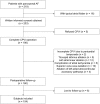Low heart deceleration capacity imply higher atrial fibrillation-free rate after ablation
- PMID: 29615802
- PMCID: PMC5883009
- DOI: 10.1038/s41598-018-23970-7
Low heart deceleration capacity imply higher atrial fibrillation-free rate after ablation
Abstract
How deceleration capacity (DC) and acceleration capacity (AC) of heart rate associated with atrial fibrillation (AF) and ablation is still not clear. The dynamic changes of AC, DC and conventional heart rate variability (HRV) parameters were characterized in 154 subjects before circumferential pulmonary veins isolation (CPVI) and three days, 3 months and 6 months after CPVI. The DCs of the recurrent group decreased significantly at each time point after CPVI; the DCs of the recurrence-free group before CPVI and three days, 3 months and 6 months after CPVI were 7.06 ± 1.77, 3.79 ± 1.18, 4.22 ± 1.96 and 3.97 ± 0.98 ms respectively, which also decreased significantly at each time point and were significantly lower than these of recurrent group. Conversely, the AC of recurrent and recurrence-free groups increased significantly at each time point after CPVI; the ACs of recurrence-fee group were significantly higher than these of recurrent group at each time point. No stable difference trend of HRV parameters was found between two groups. Further Kaplan-Meier analysis showed that DC < 4.8 ms or AC ≥ -5.1 ms displayed significant higher recurrence-free rates. In conclusion, high AC and low DC imply higher AF-free rate after ablation.
Conflict of interest statement
The authors declare no competing interests.
Figures



Similar articles
-
Reduced residual conduction gaps and favourable outcome in contact force-guided circumferential pulmonary vein isolation.Europace. 2016 Apr;18(4):531-7. doi: 10.1093/europace/euv206. Epub 2015 Sep 7. Europace. 2016. PMID: 26346921 Free PMC article.
-
Denervation as a common mechanism underlying different pulmonary vein isolation strategies for paroxysmal atrial fibrillation: evidenced by heart rate variability after ablation.ScientificWorldJournal. 2013 Aug 24;2013:569564. doi: 10.1155/2013/569564. eCollection 2013. ScientificWorldJournal. 2013. PMID: 24058286 Free PMC article. Clinical Trial.
-
Linear ablation in addition to circumferential pulmonary vein isolation (Dallas lesion set) does not improve clinical outcome in patients with paroxysmal atrial fibrillation: a prospective randomized study.Europace. 2015 Mar;17(3):388-95. doi: 10.1093/europace/euu245. Epub 2014 Oct 21. Europace. 2015. PMID: 25336665 Clinical Trial.
-
Pulmonary Vein Isolation Alone Versus Additional Linear Ablation in Patients With Persistent Atrial Fibrillation Converted to Paroxysmal Type With Antiarrhythmic Drug Therapy: A Multicenter, Prospective, Randomized Study.Circ Arrhythm Electrophysiol. 2017 Jun;10(6):e004915. doi: 10.1161/CIRCEP.116.004915. Circ Arrhythm Electrophysiol. 2017. PMID: 28611206 Clinical Trial.
-
Comparisons of the underlying mechanisms of left atrial remodeling after repeat circumferential pulmonary vein isolation with or without additional left atrial linear ablation in patients with recurrent atrial fibrillation.Int J Cardiol. 2017 Feb 1;228:449-455. doi: 10.1016/j.ijcard.2016.11.020. Epub 2016 Nov 7. Int J Cardiol. 2017. PMID: 27870975
Cited by
-
A refined method of quantifying deceleration capacity index for heart rate variability analysis.Biomed Eng Online. 2018 Dec 18;17(1):184. doi: 10.1186/s12938-018-0618-x. Biomed Eng Online. 2018. PMID: 30563515 Free PMC article.
-
Short-term deceleration capacity: a novel non-invasive indicator of parasympathetic activity in patients undergoing pulmonary vein isolation.J Interv Card Electrophysiol. 2025 Mar;68(2):455-464. doi: 10.1007/s10840-024-01899-4. Epub 2024 Aug 20. J Interv Card Electrophysiol. 2025. PMID: 39162917 Free PMC article.
-
Assessing heart rate fragmentation to predict atrial fibrillation in the general population aged 65: the PROOF-AF study.Eur Heart J Open. 2025 Mar 19;5(3):oeaf030. doi: 10.1093/ehjopen/oeaf030. eCollection 2025 May. Eur Heart J Open. 2025. PMID: 40313732 Free PMC article.
-
Changes in heart rate variability parameters following pulsed-field ablation in patients with atrial fibrillation: A systematic review and meta-analysis HRV changes after pulsed-field ablation in AF.Int J Cardiol Heart Vasc. 2025 Aug 13;60:101766. doi: 10.1016/j.ijcha.2025.101766. eCollection 2025 Oct. Int J Cardiol Heart Vasc. 2025. PMID: 40837616 Free PMC article. Review.
References
Publication types
MeSH terms
LinkOut - more resources
Full Text Sources
Other Literature Sources
Medical

